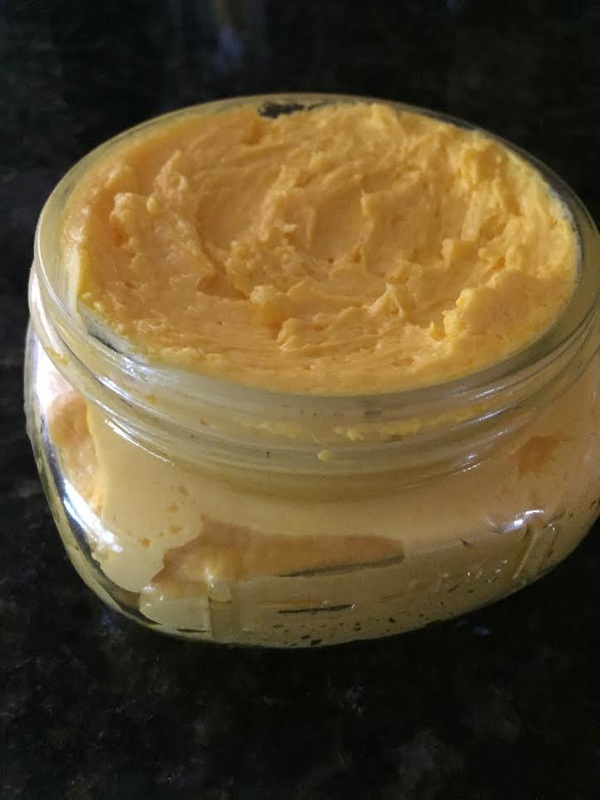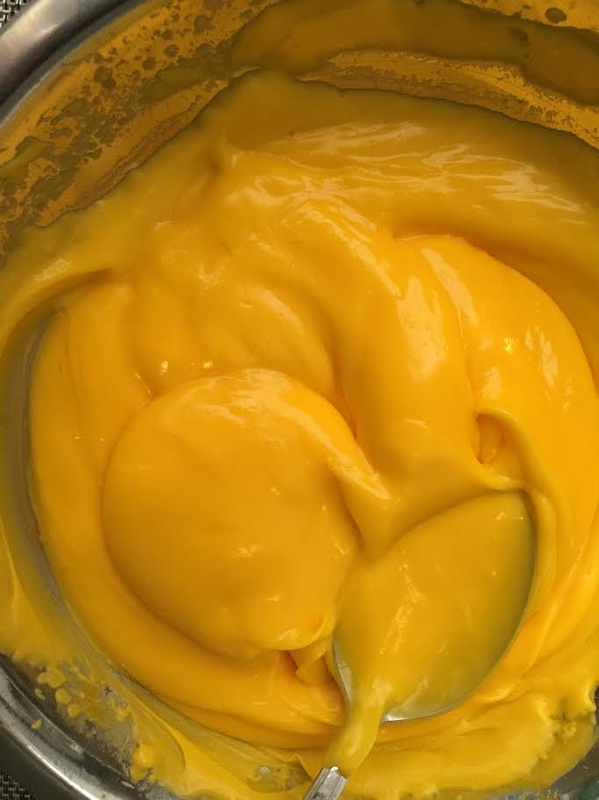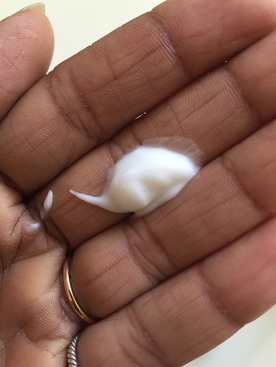|
I have experimented with a variety of oils in lotions and creams. This time, I decided to work with sea buckthorn berry oil. Here's an excellent profile of this oil by Swift Crafty Monkey. I had bought some of this oil to make the Antioxidant serum and wanted to try making a body cream featuring this oil. With winter approaching, I wanted something ultra moisturizing and thick. So I opted for sesame oil and decided to use Ecomulse, an emulsifier approved for use in organic natural products, to get a thick creamy consistency. When I was researching if there were any body creams that were commercially available with sea buckthorn oil, I came across an interesting product Bee By The Sea. Of course, I went straight to the ingredients and was really surprised to see there's no emulsifier in this product!!!!! Here are the list of ingredients: Aqua, Carthamus Tinctorious (safflower) seed oil, Aloe Barbadensis leaf juice, Honey, Tocopheryl Acetate, Panax Ginseng Root Extract, Cyclopentasiloxane, Hippophae Rhamnoides (Sea Buckthorn) oil, Royal Jelly, Panthenol, Polysorbate 20, Parfum (contains 100% pure sweet almond oil), Retinyl Palmitate, Ascorbic Acid It appears that the product has maybe atleast 10% safflower seed oil and water and no recognizable emulsifier. Sometimes I wonder if people forget to list all the ingredients in their products ... Anyways, back to my creation. I decided to use water, aloe vera juice, and veg. glycerin for my water phase and sesame oil, ecomulse, cetyl alcohol, and sea buckthorn oil for my oil phase. As usual, I continued to have trouble with the ecomulse. Things were going just fine: I had a rich cream until I added the preservative - when the thing started to get unstable. I reheated it and managed to salvage it. The orange color is from the Sea Buckthorn berry oil - it has a lot of Beta Carotene - that gives it the orange hue. The cream looks like a rich butternut squash soup or mango puree. My mango loving daughter saw it on the stove and demanded to eat it :-)
What are some of the purported benefits of this cream? The sea buckthorn oil is supposed to be good for eczema, psoriasis, burns, cuts, wounds. Sesame oil is a rich moisturizing oil also rich in vitamins like sea buckthorn. So my hope is this cream will be perfect for the approaching winter and also ease the bug bites (and resulting scratched skin) that my kids seem to periodically suffer from.
1 Comment
I recently purchased a new emulsifier - ecomulse (inci: glyceryl stearate (and) cetearyl alcohol (and) sodium stearoyl lactylate) from lotioncrafter. "Ecomulse is a natural source, self-emulsifier for oil in water emulsions. It contains no ethoxylated ingredients. This system is based on acyl lactylates, which are conditioning to both hair and skin." Ecomulse is also approved for use in certified organic products - one of the main reasons I was tempted to try it. In my previous post, I described my starting trouble with this emulsifier. That led to a series of experiments in the kitchen and a series of products! Before I started making my own creams and lotions, I used to use cetaphil for the kiddos. I liked the feel of the cream - it does feel rich and goes on super smooth. I decided to try and reverse engineer (what's the appropriate word for chemistry???) the cream. Here are the ingredients in cetaphil: Water, glycerin, petrolatum, dicaprylyl ether, dimethicone, glyceryl stearate, cetyl alcohol, sweet almond oil, peg-30stearate, tocopheryl acetate, acrylates/c10-30 alkyl acrylate crosspolymer, dimethoconol, benzyl alcohol, phenoxyethanol, methylparaben, propylparaben, glyceryl acrylate/acrylic acid copolymer, propylene glycol, disodium edta, sodium hydroxide. Wow - that's some ingredient list. Let's see what all those chemicals do for the cream. Water - of course is the main ingredient. Judging by how thick the cream is, I'd say about 60% - 65% by weight. Interestingly glycerin comes next. That indicates that it's the next most abundant chemical in the cream. Glycerin is a triol - C3H4(OH)3 and is used as a humectant - something that draws water from the atmosphere - in skin care products. (as an aside, glycerine can be derived from plants as well as made synthetically. Usually the plant derived glycerine is referred to vegetable glycerine while the synthetic glycerine is just glycerine.) synthetic glycerine is a byproduct of the petroleum industry - propylene which is an intermediate in the petroleum distillation process is halogenated (reated with chlorine) and then hydrolyzing (convert to the triol). I am pretty sure that the glycerin in cetaphil is synthetic as it does not say vegetable glycerin. Anyways, the interesting point is that it's the second ingredient on the list. There are other humectants that come way down at the bottom (so probably only about 1% by weight) - glyceryl acrylate/acrylic acid copolymer, propylene glycol. Petrolatum - petroleum jelly - a byproduct of the petroleum industry. This is an occlusive - prevents water from evaporating from the skin's surface by forming a film. Dicaprylyl ether and dimethicone are emollients - skin softening a soothing agents. Next is our emulsifiers - glyceryl stearate, cetyl alcohol, peg 30 stearate to keep the water and oil (sweet almond) together. Oils are added to lotions to prevent water from evaporating from the skin. Tocopheryl acetate is the ester of acetic acid and tocopherol aka vitamin e. It's an antioxidant and commonly added to skin care products at 1% to prevent oils from going rancid. Acrylates/c10-30 alkyl acrylate crosspolymer is used to increase the viscosity of an emulsion - probably accounts for the nice thick consistency of the cream. Probably also functions as an occlusive? - forms a barrier on the skin to prevent water from evaporating. Dimethoconol is also an occlusive. Then comes a long list of preservatives - benzyl alcohol, phenoxyethanol, methylparaben, propylparaben. Tetrasodium edta is a chelating agent - meaning it binds to metallic ions in an aqueous environment and is used in skin care products to improve preservative efficacy (0.1%). And then finally sodium hydroxide - likely to balance the ph of the resulting cream. Phew - so in my experiments, I did not use any of the polymers (occlusives) as I am inspired by natural products (a long post on that coming). Ecomulse (when I could get it to work finally) produces a pretty nice emulsion - feels really smooth. This was really my inspiration to try and create the cetaphil like cream. I started with 10% glycerin and got a cream so thick and erm .... super sticky. I then went down to 5% glycerin - this was creamy and not sticky. I am a glycerin fan - it does wonders for the skin. My question is how come Cetaphil does not feel sticky given the second ingredient is glycerin??? How? The 10% glycerin cream sits on my end table to be used as a foot cream. My next attempt was to play around with the oil concentration to make a "silky light" facial lotion. Started with 10% and went down to 5%. The 10% oil lotion feels like cold cream - a bit heavy. The 5% one feels a lot lighter so that's what I'm going to go with. Another thing I found out - since I wanted the lotion to be light, I started with 5% Ecomulse. And ended up with a very thin colloidal cloudy thing. I had already blended the water and oil phase by then - but decided to throw in 2% more of the Ecomulse in the mixture and heated it again. This is a serious no-no in lotion making - adding a second dose of emulsifier after blending is not done. But guess what, I ended up with beautiful lotion in minutes!!! My goal for this facial lotion was to make it silky, light and smell like the Saffron Elixir serum - ylang ylang, grapefruit, and sandalwood. I love love love this essential oil combination I concocted. So far, the lotion is light, and smells the way I wanted it to. Need to test for a few days to see how my face feels.
My overall take on Cetaphil - it works OK for eczema if you diligently use tons of it. It feels really good - it glides and is non-greasy. I do not approve of the ingredients (part of my natural products post coming soon). My daughter had eczema and I was advised by her dermatologist that the only way to manage it was to go through a pound of Cetaphil (or equivalent) in 3 weeks for the rest of her life!!! Heck no - she now has a smooth and glowing face thanks mostly due to vegetable glycerin. I have been making emulsified body butters for a while for the kids. What's an emulsified body butter? It's a thick cream made of water, oils, and a butter such as shea, cocoa or mango butter. Of course this needs an emulsifier to keep it all together. I set about making a batch of emulsified body butter - 70% water phase, 12.5% oils, 6% butter, 8% ecomulse - an organic emulsifier from lotioncrafter (inci glyceryl stearate (and) cetearyl alcohol (and) sodium stearoyl lactylate). The preservative i generally use is Neodefend (also from lotioncrafter) (inci gluconolactone and sodium benzoate). I add this to the heated water phase and had no issues with emulsifying wax nf (cetostearyl alcohol) from mountain rose herbs. I did the same thing and ended up with a runny mess that then separated. So instead of this I get this: I scoured the internet for what might have gone wrong and got a vague idea that it could be the preservative - it's probably a bit too acidic for the Ecomulse. I went back and made a face lotion without the NeoDefend and the lotion emulsified beautifully in no time after mixing the oil and water phases. I ended up using Optiphen preservative (INCI Phenoxyehanol and caprylyl glycol) in the cool down phase. The Ecomulse seems to be creamier than Emulsifying wax but definitely needs more TLC.
Based on feedback I've got from a few wonderful folks, I seem to make my face lotions a bit oily. So I have made a batch of face lotions with varying degrees of oils. These will go out to testers. |
|
|
© Saroya Natural 2023 | All rights reserved.
Website designed by Aadi M |
Contact Us |









 RSS Feed
RSS Feed